Headphone-Amp Compatibility Test
One of the things a proper speaker
review does is deliver a notion of what type of amplifier would be an appropriate match
for the speaker. However, even though the frequency responses and sensitivity ranges of
headphones vary just as much as they do in speakers, matching an amp to a particular set
of 'phones normally gets little attention. But here today, four headphone amplifiers and
five current headphones (plus a vintage favorite) battle it out to see which combinations
work and which you should stay away from.
The source material
Sony DVP NC-650V CD/DVD/SACD changer: around $250 when
new, circa summer 2002: I keep meaning to replace this five-disc DVD/CD/SACD changer
with something better, but as budget players go, its sound quality, particularly when
playing SACDs, is surprisingly hard to beat. Its headphone jack is of average quality for
a home CD player, sounding somewhat better than most portable CD players driving
headphones.
The Alan Parsons Project: I Robot [Classic DAD
1035]: When you’re going to play a single track 24 times, it helps if it’s a
favorite you won’t wear out. "Some Other Time" was my consistent reference
track here for most of the comparisons. With its wide range of dynamics and detail, this
24-bit/96kHz DVD is the one disc I use for reviews if I can use only one.
The Police: Synchronicity [A&M 069 493
606-2]: "Wrapped Around Your Finger" is the keeper track on this SACD for
equipment evaluation.
Radiohead: OK Computer [Capitol CDP 8 55229 2]:
"Karma Police" is a somewhat dirty-sounding monster of a track that headphones
find particularly difficult to navigate.
All RCA-jack analog interconnects were 1m lengths of JPS
Ultraconductor ($109). Mini-jack connections were made with 16" Straight Wire cables
($20).
The HeadRoom amps
The HeadRoom process enhances your ability to hear stereo
effects on headphones by routing some of the signal from each ear into the other. There is
also a slight tonal balance shift that usually makes the sound a little duller and the
bass thicker. The result is usually subtle, but it can sometimes be dramatic. The biggest
difference I heard was on that classic of studio-panned stereo separation,
"Doolin-Dalton," from the Eagles’ Desperado [Asylum 5068-2]. Try
this track if you doubt the ability of the HeadRoom process to radically alter how you
perceive a piece of music.
 HeadRoom Total AirHead ($199):
HeadRoom’s AirHead amp is a continually improving product, and I’ve been
checking it out periodically since mid-1998. The earliest versions were in a rectangular
box; the first version shipping in any quantity switched to the current, more curvilinear
chassis. The product was split into standard AirHead and Total AirHead versions a few
years back. This latest update uses three batteries instead of two, and adds a small green
power light to the front of the unit. AirHeads have gotten slightly more powerful and
considerably quieter over the years, and the current incarnation is a very capable little
unit. There’s no filter adjustment on this amp; you get only the treble EQ HeadRoom
has built into the process for this amp, which is actually a good average setting. HeadRoom Total AirHead ($199):
HeadRoom’s AirHead amp is a continually improving product, and I’ve been
checking it out periodically since mid-1998. The earliest versions were in a rectangular
box; the first version shipping in any quantity switched to the current, more curvilinear
chassis. The product was split into standard AirHead and Total AirHead versions a few
years back. This latest update uses three batteries instead of two, and adds a small green
power light to the front of the unit. AirHeads have gotten slightly more powerful and
considerably quieter over the years, and the current incarnation is a very capable little
unit. There’s no filter adjustment on this amp; you get only the treble EQ HeadRoom
has built into the process for this amp, which is actually a good average setting.
 HeadRoom Cosmic ($729): I’ve
heard three HeadRoom Cosmics over the years. The first had a two-position brightness
filter switch, and the second included a filter switch with Regular, Bright, and Brighter
settings. The current production looks the same as the previous run, but now includes a
15V power supply when you’re using it from an AC outlet, jacked into the remote input
instead of the DC voltage input. The Cosmic can also be made portable by running it off
four D-cell batteries, which provide a little over 6V of power. The sound-quality
differences between 15V and 6V operation can be substantial, as you’ll see in the
individual headphone comments, so the power-supply upgrade of this new version really does
greatly improve this amp’s performance. Unless stated otherwise, all comments assume
the 15V power supply. HeadRoom Cosmic ($729): I’ve
heard three HeadRoom Cosmics over the years. The first had a two-position brightness
filter switch, and the second included a filter switch with Regular, Bright, and Brighter
settings. The current production looks the same as the previous run, but now includes a
15V power supply when you’re using it from an AC outlet, jacked into the remote input
instead of the DC voltage input. The Cosmic can also be made portable by running it off
four D-cell batteries, which provide a little over 6V of power. The sound-quality
differences between 15V and 6V operation can be substantial, as you’ll see in the
individual headphone comments, so the power-supply upgrade of this new version really does
greatly improve this amp’s performance. Unless stated otherwise, all comments assume
the 15V power supply.
 HeadRoom Maxed Out Home ($999):
The original Maxed Out Home amplifier had a two-position filter switch. The current
version includes a three-position filter switch, three-position gain switch, and
two-position ground-lift switch. HeadRoom Maxed Out Home ($999):
The original Maxed Out Home amplifier had a two-position filter switch. The current
version includes a three-position filter switch, three-position gain switch, and
two-position ground-lift switch.
The headphones and results
Grado SR60 ($69): The Grado SR60 is cheap, and
compatible with low-output headphone jacks. The SR60s had decent frequency extension but
not much resolving power; "spunky" is how I’d quickly summarize their
sound. I modified my Grados a little bit by cutting out the middle of the earpiece to
expose the center section of the driver. This substantially improved fidelity in the
midrange and high frequencies with only a small loss in comfort.
With Sony: Solid playback but a little bass-heavy,
with some distortion on high-level bass.
 With AirHead: Much-improved sense
of recording space and overall detail with this amp, great balance, and very little feel
of dynamic compression. With AirHead: Much-improved sense
of recording space and overall detail with this amp, great balance, and very little feel
of dynamic compression.
With Cosmic: De-emphasized the midrange a bit
compared to the cheaper amps, which really worked against the SR60s.
With Maxed Out Home: Slightly sharper dynamics than
with the Cosmic, but otherwise not much difference.
Recommendation: AirHead, but you could certainly get
by even without a dedicated headphone amp.
HeadRoom Process Compatibility: Average. The process
itself puts a blanket over vocals, but it worked fairly well when I combined it with the
Brighter setting. On the AirHead, the combination of the process and filter worked even a
little better than the Cosmic and Maxed Out Home process settings could achieve, but I
still preferred the Grados’ sound unprocessed.
Koss Pro-4AA ($100): Because these headphones were
what first got me listening to good audio back in the 1970s, I figured it would be fun to
hook them up to modern equipment and listen to them again. I used my original, decades-old
pair of Pro-4AAs; new-production models are available.
With Sony: Played fine up to medium volume, but
without much detail.
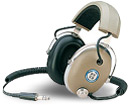 With AirHead: Can’t plug
them in without an adapter, so I didn’t test. With AirHead: Can’t plug
them in without an adapter, so I didn’t test.
With Cosmic: This could play much louder and cleaner
than the Sony’s output.
With Maxed Out Home: Really made vocals come alive.
My old Kosses sounded surprisingly good with this big amp running the show.
Recommendation: Maxed Out Home, but the Cosmic is
workable and the Sony is OK.
Beyerdynamic DT 250-80 ($199): I could enjoy
these enormously comfortable, studio-style headphones even for very long listening
sessions. Their dark, reserved character was the complete opposite of similarly priced
models from AKG or Sennheiser.
With Sony: Nice, full sound with surprisingly
powerful bass.
With AirHead: A bit more very-deep-bass growl than
with the Sony.
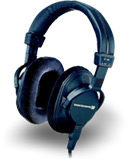 With Cosmic: Substantially
more detail with this amp than with any of the cheaper ones. Sounded fine with either the
15V or 6V power supply. With Cosmic: Substantially
more detail with this amp than with any of the cheaper ones. Sounded fine with either the
15V or 6V power supply.
With Maxed Out Home: Even more detail and resolving
power than with the Cosmic. I could hear well into the noise floors of the recordings with
this combination.
Recommendation: Any of these amps will work well,
but the Maxed Out Home sounded the best. The Beyerdynamic DT 250-80s let me compare
the amps at a level that revealed their strengths and weaknesses. For example, the
percussion snaps in The Police’s "Wrapped Around Your Finger" are
particularly difficult to reproduce faithfully. With the Maxed Out Home, the sounds hung
in space, with clear echoes and a real presence. Using the Cosmic, I got most of that feel
with the 15V power supply; I still heard some echo when I switched to the 6V supply, but
the feeling of space just wasn’t there. The AirHead delivered the main snap, but
without the sense of space.
HeadRoom Process Compatibility: The Beyerdynamics
were a little on the dull side with the process engaged. The filter worked fairly well,
giving a decently balanced presentation.
AKG K501 ($245): AKG’s K501s are big, comfy
'phones that make you look like a recording-studio headphone geek. They reminded me of
electrostatic home speakers: they required lots of power and had limited bass, but make up
for it in detail.
With Sony: At full volume, this combination was just
barely usable, with very broken, distorted sound.
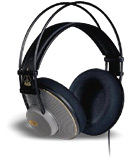 With
AirHead: The sound was decent, but only at low volumes. The bass, in particular, broke
up as soon as I tried to increase the volume. With
AirHead: The sound was decent, but only at low volumes. The bass, in particular, broke
up as soon as I tried to increase the volume.
With Cosmic: I got what I consider normal rock
listening levels out of this combination, but it wouldn’t play any louder than that.
There was a big difference in sound when I switched power supplies. Dynamics were
satisfying with the 15V supply, but collapsed with the 6V supply.
With Maxed Out Home: This combo played fairly loudly
but was substantially more distorted on difficult transients than any of the other
headphones in this survey.
Recommendation: Maxed Out Home. A Cosmic with 15V
supply will just barely do the job.
HeadRoom Process Compatibility: This worked well.
The tonal balance was softened and the extra bass was welcome. No need to add any
brightness with the filter.
Sennheiser HD 580 ($260): The Sennheiser
HD 580s are somewhat bright in the high frequencies, but not as much as the AKG
K501s. I felt the HD 580s had a better overall balance of sound, and their amplifier
compatibility was much broader.
With Sony: Way too bright and thin at any volume.
With AirHead: Much better, but still a bit thin.
There was clearly not enough power to drive the HD 580s happily.
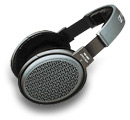 With Cosmic: Finally, enough
power to get the Sennheisers going. The vocals in particular were, surprisingly, much
improved, and there was better frequency extension at both extremes with the 15V power
supply. With Cosmic: Finally, enough
power to get the Sennheisers going. The vocals in particular were, surprisingly, much
improved, and there was better frequency extension at both extremes with the 15V power
supply.
With Maxed Out Home: These 'phones really came
alive. The playback was much brighter than most headphones with this setup.
Recommendation: Maxed Out Home. A Cosmic with 15V
power supply is workable.
HeadRoom Process Compatibility: Poor, and easily the
worst of any headphone in this review, with excessively fat bass. I could improve things
by switching the filter to Bright, but the sound was still a little off. This is not the
combination you want to fairly evaluate the HeadRoom process, as far as I’m
concerned.
Etymotic Research ER-4S ($330): Etymotic
Research’s ER-4S headphones are revealing, demanding, and offer extraordinary
isolation from the outside world, but they’re very sensitive to electronic noise. My
pair includes custom ear molds that help improve isolation and bass response over the
stock system.
With Sony: This setup could play moderately loudly,
but the DVD player wouldn’t drive the Etymotics to any appreciable volume without
serious distortion in the bass.
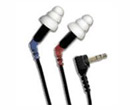 With AirHead: Great match, with solid bass and excellent tonal balance. With AirHead: Great match, with solid bass and excellent tonal balance.
With Cosmic: There was a ragged sound with this
combination that was not satisfying, with a particularly harsh treble. With the 6V supply,
this got even worse. When playing CD sources, I heard some noise that showed up with no
other amp.
With Maxed Out Home: A little less shrill than with
the Cosmic, but no longer excessive. Both the Maxed Out Home and the ER-4S have an excess
of resolving power; the combination was brutally revealing.
Recommendation: AirHead.
HeadRoom Process Compatibility: Good. The process
removes some of the Etymotics’ tendency toward thinness. Even with the process
engaged, I didn’t need to increase the brightness.
...Greg Smith
Links to company sites:
|